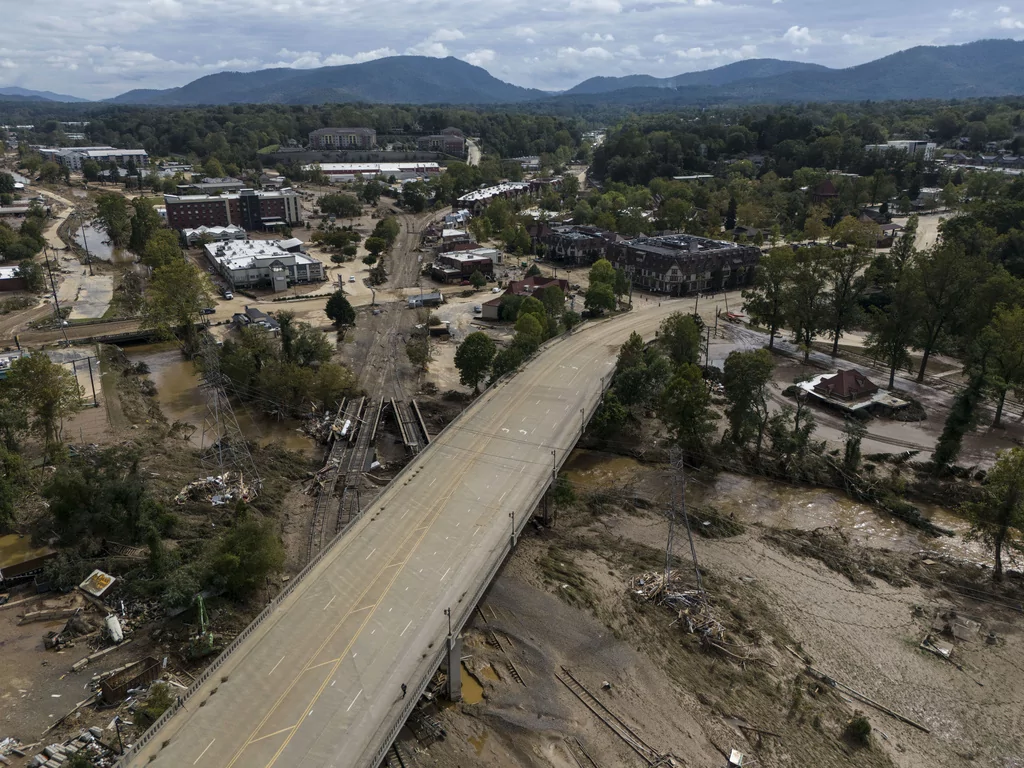

Residents of Asheville, North Carolina, began to see more aid and relief Monday, days after the remnants of Hurricane Helene devastated the city that many have said was unprepared for the severe storm.
Parts of the city, which is located in the Western region of the state, were nearly totally isolated over the weekend after major flooding and heavy rains knocked out bridges, tore apart streets, and turned roadways into waterways.
As of Sunday, the state warned residents that all roads in Western North Carolina should be considered closed. In Asheville, Gov. Roy Cooper’s (D-NC) office said only part of Interstate 26 south was to be considered the major road in and out of the city.
Devastating photos show homes in the area flooded and destroyed. The devastation from the storm has left at least 40 people dead and more than 1,000 people missing in Buncombe County alone.
The storm first made landfall Thursday, more than 400 miles away in Florida’s Big Bend region. Hurricane Helene is the strongest hurricane recorded to hit the area and swiftly weakened to a post-tropical cyclone as it made its way inland. In the disastrous aftermath of the storm, many have questioned why North Carolina was hit so hard.
Why were locals unprepared?
As Helene made its way north Thursday into Friday, residents in Western North Carolina said they were caught off guard by the storm. Many said they were confident in the mountain range protecting them, others said they didn’t get enough warning to leave, and some said the effects of Helene came faster than expected.
“I think everyone was unprepared for this,” North Carolinian Richie Gedihovic told NPR’s WFAE. “I got an emergency message to evacuate at 5 a.m. yesterday morning, but it was too late and already flooding.”
Asheville resident Alyssa Wilson agreed, telling NBC News that she didn’t believe the town received ample warning to evacuate. Wilson claimed that all they had received via their phones were severe storm warnings. However, she said concerns did not grow as parts of the city are known to flood during regular rain storms.
“We weren’t prepared for the severity of the storm,” Wilson said. “Nobody was prepared.”
“I never knew anything like this could happen here,” added Avery Dull, who lives about 25 miles outside of Asheville in Hendersonville.
She told CNN that she and her neighbors were “extremely unprepared.”
“Luckily we were on high ground, but those people lost everything,” Dull said. “Half of my neighborhood is underwater and dozens of families are trapped inside of their homes. Cars have been completely submerged and totaled, and power is out across the county.”
Others who attempted to prepare were even caught off guard.
“We were not prepared, I don’t think anybody was prepared for this,” former Greenwood Mayor Welborn Adams told the State.
Adams explained that his family had even stocked up on food.
As residents continue to grapple with the destruction caused by the storm, which has left dozens of people missing and dead, many have accused the federal government of not supplying enough aid and relief in the aftermath. On Sunday, locals revealed that parts of town don’t have drinking water, food supplies, and gas.
By Monday, more supplies from the Federal Emergency Management Agency and other aid groups were being sent to Asheville by air, truck, and mule, according to the Associated Press. However, as emergency responders and rescue teams continue to help those in areas cut off by flooding and destroyed roads, Cooper warned the death toll is expected to rise.
It was not immediately clear if agencies such as FEMA had put in place proactive measures ahead of the storm, besides evacuation warnings and calls to stock supplies, in an attempt to curb its effects in Western North Carolina.
Days before the storm hit, the National Weather Service issued a stark warning about Helene’s effects, and said it could cause “catastrophic, life-threatening inland flooding.”
FEMA did not immediately respond to the Washington Examiner’s request for comment.
Is this unprecedented?
In the aftermath of the storm, many on social media have said the disastrous effects were unimaginable in a region like the Appalachian mountains, which are hours away from the coastline.
However, in 1916 a similar devastating flood hit that part of the state.
The city of Asheville has said during that flood, 80 people died, power plants were destroyed, and residents were left scrambling into trees to escape the flooding waters.
“By any measure Asheville’s catastrophic Flood of 1916 stands as ‘The Flood by Which All Other Floods Are Measured,’” according to the city’s website.
Ahead of Helene, forecasters began to warn that the storm could bring similar effects with the National Weather Service predicting it would be “one of the most significant weather events” to happen in western parts of North Carolina in modern history.
While this appears to be the first weather event to have similar or even worse effects than the 1916 flood, it is not unprecedented for the mountain region to see the remnants of a hurricane or tropical storm.
In 2004, Western North Carolina was ravaged by Hurricane Frances, a Category 4 hurricane that later weakened to a tropical storm. Towns such as Canton, Clyde, and Asheville saw flooding after getting more than 12 inches of rain.
As recently as August, when slow-moving Hurricane Debby first made landfall in Florida, Asheville residents were warned of heavy rains. At the time, the North Carolina Department of Transportation urged locals to monitor the changing forecast and to stock up on food, water, and other supplies. It also warned that the state could see flooding and damage to the roads.
Why was the region hit so hard?
As Helene made its way to the United States, the storm rapidly intensified into a Category 4 hurricane, sparking calls for preparation and evacuation within its path. Hurricane researchers have attributed unusually warm ocean temperatures combined with swift changes in wind heights as a likely reason for the intense development.
While Helene weakened after making landfall in Florida, Western North Carolina appeared to suffer from the bulk of the devastation brought on by the storm.
So what’s the reason why? Experts are saying location.
It is commonly thought that mountains can protect against severe weather, such as tropical storms. However, higher elevation and cooler temperatures can actually have adverse effects.
CLICK HERE TO READ MORE FROM THE WASHINGTON EXAMINER
Christiaan Patterson, a National Weather Service meteorologist, told the outlet that towns such as Asheville were built in valleys in the Appalachian mountains. As severe storms hit the regions, elevation and cold temperatures can cause more rain to fall leading to landslides, mudslides, and flooding. Patterson explained that by the time Helene made it to the region, the ground was already saturated, meaning it could not absorb any more water.
In the wake of the storm, North Carolina’s governor has called Helene “one of the worst storms in modern history” for parts of the state.







